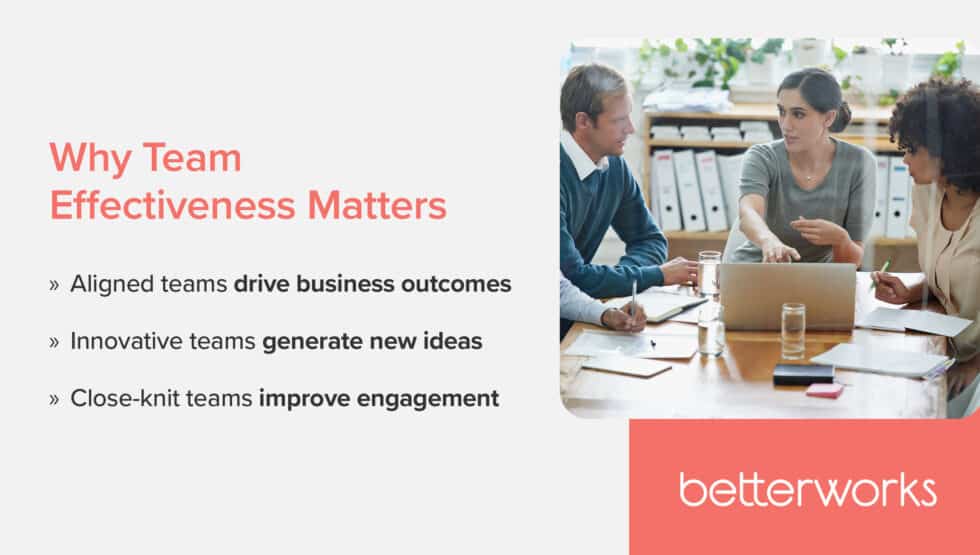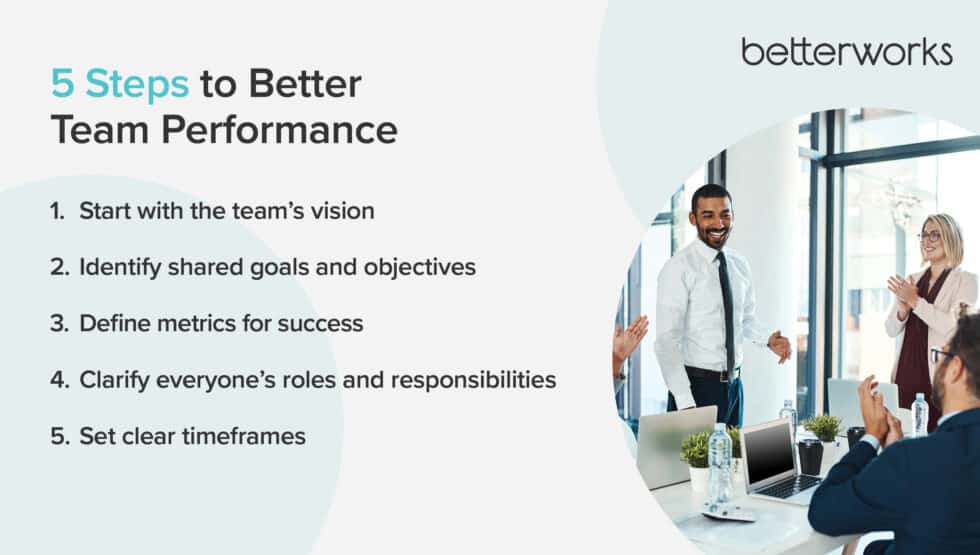

Most conversations about performance focus on individual employees and their managers. But most employees are part of larger teams whose collective performance matters. An action plan for improving team effectiveness should be a key feature of your performance management process.
Effective teams drive business results, while dysfunctional teams reduce efficiency and waste time and resources. The good news is that helping teams improve their performance significantly affects the business’s ability to succeed and grow.
Learn about team effectiveness, and check out our action plan for empowering managers to lead better, more productive teams.

When operating at peak efficiency, your workforce is like a well-oiled machine — all parts move together in alignment and without friction to produce desired business outcomes. But misaligned team members will have different priorities, duplicate each other’s work or even work at cross purposes.
Teams are the building block of every organization. Effective teams are more than the sum of their parts. Where individuals alone can excel, teams operating effectively together can go even further. Teams can bounce ideas off each other, experiment with new ways of working, and help each other through challenging times — all actions that elevate the entire group.
Close-knit teams also facilitate friendships, foster higher morale, and improve engagement. That personal touch and sense of connection are essential for remote team members at additional risk of feeling isolated.
You need to monitor team performance just as you’d manage employee performance. Action plans prioritize the most important information (goals, key performance indicators, and outcomes).
A performance plan allows teams to prioritize what’s most important based on their goals, historical performance, skills, and abilities. Managers can use team performance plans to identify gaps in productivity and lay out specific performance-improvement goals to drive business results.
Like a one-on-one performance improvement plan, an action plan for improving team performance sets clear goals and provides direction for growth. Train managers to take these steps toward improving team effectiveness.
Every team in your organization is necessary for achieving the business’s vision. A team’s vision — just like the business vision — articulates where the team wants to go. It provides an aspirational goal for the team to work toward.
Help managers talk to the team about its role in achieving the larger business vision to draw inspiration for the team’s vision. Writing a team vision statement is a good exercise for building alignment and facilitating purposeful conversations.
When creating a team performance improvement plan, make sure that managers consider that vision. Each team’s goals and action items should push the vision forward, continually reinforcing the alignment between the team and the larger organization.
Each team should align its goals with higher-level goals. Train managers to properly communicate what goals their teams are supporting. These team goals should also specifically address the performance areas most needing improvement.
Team goal-setting should be a collaborative process. Teach managers how to effectively gather input from each team member and weigh everyone’s viewpoints and unique strengths.
Teams need clear goals with defined criteria for measuring performance improvement. SMART goals are specific, measurable, attainable, relevant, and time-bound. Setting team goals within this framework supports clarity and allows all participants to feel comfortable committing to the plan.
Recommended Read
With goals in place, the next step is determining KPIs that indicate a team’s progress against its objectives. Tracking KPIs helps managers see whether there have been improvements in performance, no change, or declines in performance. Managers can also use KPI data to make educated guesses about performance roadblocks and what’s causing them.
Teams can’t improve their performance without clarity around each individual’s roles and responsibilities. Poorly defined roles and responsibilities could be why teams aren’t performing well in the first place. When teams and managers aren’t on the same page, performance results are the first to suffer.
Approval software can help you visually demonstrate each team’s reporting structure and roles and which team members are responsible for completing each task.
One of the elements of SMART goals is “time-bound,” requiring leaders to define the timeframe for achieving results. Setting a quarterly goal is common for short-term goals, while longer-term goals could be annual.
Set a suggested cadence for manager-team check-ins, much like you would with manager-employee conversations. These check-ins should review progress, course-correct if necessary, and allow for input and observations. Train managers to host these team meetings in a stand-up style, with each employee reporting on their tasks and progress. These meetings should stick to the agenda; other concerns can be addressed separately, especially if they involve individual problems or roadblocks that don’t directly affect the team’s goals.

Managers have a lot of responsibilities to balance. These best practices for improving team effectiveness can help HR leaders and managers create a culture where teams feel empowered to strive for greatness.
Teams in your organization need resources and time to improve their effectiveness. Make sure they know what those resources are, how to use them, and where to access them. For example, if your business uses Shopify, it’s beneficial for team members to know how to easily add products on Shopify blogs, as this can streamline operations and enhance marketing efforts.
Learning resources help team leaders better manage their team’s performance. Managers should have access to learning modules via online learning systems.
Tools and templates are critical to guiding performance conversations. Templates within performance management software can help managers lead more productive discussions by focusing on what truly matters for the team, while also making it easy to collect important qualitative and quantitative data on team accomplishments and challenges.
As an element of a larger performance management system, goal alignment software can help managers clarify who’s responsible for which objectives so that everyone is clear about performance expectations. Project management software can help keep individual tasks on track, in parallel to goal tracking systems.
Recommended Read
High-performance teams are characterized by their laser-sharp focus on achieving their goals and outperforming competitors. A high-performance environment fuels shared purpose among team members, keeps goals top of mind, and empowers people to work independently within the team.
Agility and autonomy are important components of a high-performance team, too. Team members should feel like they can make decisions and move quickly without needing their manager’s approval or suffering from second-guessing. A high level of trust fosters an environment of experimentation and innovation, where team members are empowered to do their best work without being punished for reasonable failures or setbacks.
Fostering a high-trust environment can be challenging for team leaders, who must be willing to give their reports freedom to learn in the flow of work. The manager’s role here is to provide guidance through coaching, offer constructive feedback, and remove roadblocks to the team’s success.
Managers sometimes need help finding the balance between guiding teams and directing them. Train managers to recognize how their teams work most effectively. That awareness can help them understand when they must step in and when they should step back.
Transparent communication with ground rules is key to building and maintaining team trust. Better communication includes helping managers and teams choose their words and tone wisely. But it also covers the technology employees use and the circumstances. For example, what communication should be synchronous versus asynchronous?
Help teams create decision trees (or fold their specific circumstances into the organization’s decision trees). Teams might decide that urgent communications should be sent via text, for example, while questions that don’t need an immediate answer can be shared via enterprise chat software. Transparency around communication will also address what counts as “urgent” communication.
Open communication includes developing an infrastructure for sharing feedback at work, which can help teams perfect their operations and performance. Continuous feedback loops allow team members to voice their thoughts on tasks, processes, and leadership. Team leaders can use that information to continue improving the work and the underlying processes.
Open and transparent communication depends on a deep sense of trust between team leads and employees. If people don’t feel safe speaking up or believe they’ll be disrespected, they won’t say anything.
Celebrating progress toward common goals reinforces the team’s shared purpose and lets them recognize each other’s contributions and teamwork. Many employee engagement software products include “kudos” boards or other avenues for team members to acknowledge each other’s efforts. These congratulatory gestures are especially important with teams that have been struggling. Recognition is a tangible sign of their improvement and also an emotional boost.
At the highest levels, incorporate shoutouts into all-hands meetings, and call out specific teams for outstanding work. Encourage individual team leaders to acknowledge success within the group. Consider providing a budget for celebrating team wins with meaningful rewards, such as gift cards, swag boxes, or curated experiences.
Don’t forget to acknowledge failure as a learning experience. That’s a different win, even if it doesn’t always feel like it. Train managers to have these tough conversations, especially when changes in processes, tools, or techniques that didn’t pan out. If managers can guide the team through a conversation about why changes didn’t work, everyone can learn and do better the next time — setting themselves up for bigger wins.